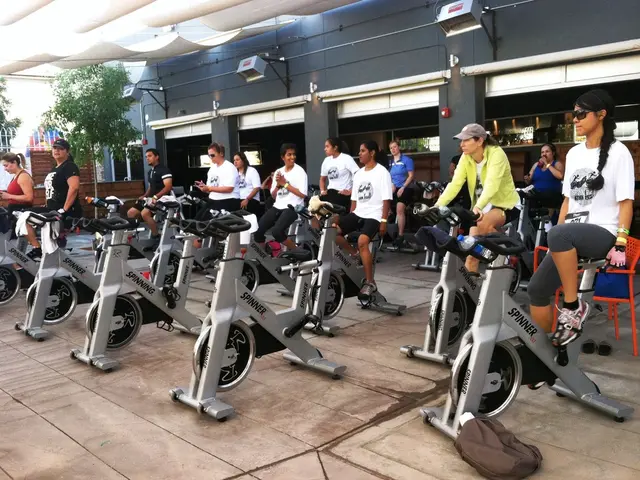Sun Protection 101: Unlocking Sunscreens and their SPF Ratings, Demystified! Answering Your 7 Burning Questions About Sunscreen
Sunscreen Protection Factor: Insights Explored
Cracking the code on sunscreens! Drowning in an ocean of sun protection options? Here, we debunk the 7 most pressing questions regarding sunscreen to help you make an informed decision and shield your skin from UV radiation this summer.
1. Getting SPF Straight:
Every sunscreen product contains a Sun Protection Factor (SPF), typically ranging from 6 to 50+, with higher values implying longer protection against sunburn as well as UV-induced damage.
To calculate the actual sun protection duration, multiply your skin's natural protection time by the SPF rating. For example, a person with skin type 1 (spending 5-10 minutes in direct sunlight before burning) using a sunscreen with an SPF of 50 would theoretically be able to stay in the sun for up to 250-500 minutes (25-500 times the natural protection duration).
However, remember that sunscreen isn't a free pass; it still doesn't offer complete UV radiation protection even with high SPF values, as stated by the Federal Office for Radiation Protection (BfS)[1]. It's essential only to exhaust the sunscreen's protective time by 60% or less to maintain maximum effectiveness.
2. Choosing the Sunscreen for You:
Skin type, personal preferences, and activities all play a crucial role when selecting the ideal sunscreen. Whether you desire a rich cream, a light gel or spray, or options designed for athletes, ensure you select a sunscreen that suits your unique needs. Moreover, don't undervalue comfort; if you prefer a formula but don't find it appealing, you'll be less likely to use it consistently.
3. When is UV Radiation Most Dangerous?
Weather, location, and time of day all contribute to UV radiation's potential harm to the skin. Don't be tricked by overcast days; UV radiation levels might be higher than on clear days[2].
Monitor the UV index (a value between 1-11+), found in common weather apps, for guidance. The BfS advises eyes and skin protection at values of 3, and avoiding midday sun exposure when values reach 8 or higher[2].
4. Sunscreen Application Done Right:
Protect all body sections exposed to the sun, even those often overlooked areas, such as ears, lips, hands, neck, and skin-clothing transitions. Athletes should prioritize water-resistant sunscreen to prevent migration into the eyes during sweating.
Pre-hydrating the skin by applying a body lotion or non-SPF skin cream improves absorption and effectiveness of sunscreen[3]. Among other features, the initial SPF applied counts for daily creams.
5. Quantifying Sunscreen Application:
People commonly apply too little sunscreen. To achieve optimal coverage, use approximately 2 milligrams of sunscreen per square centimeter of skin, or one-fifth of a 200-milliliter bottle for fully protecting an adult's body[1]. Alternatively, apply two finger lengths of sunscreen (from knuckle to fingertip) on each body region.
Sunscreen should be applied about 30 minutes before sun exposure and reapplied as needed, ideally twice for basic protection. It's essential to reapply multiple times a day while sweating, swimming, or participating in outdoor activities[2].
6. What About Kids?
Unlike adults, babies and young children lack natural skin protection. Therefore, select special sun protection options designed for children, and ensure broad-spectrum protection with mineral or physical filters[4].
Consider fragrance-free and hypoallergenic sunscreen formulations to minimize the risk of allergies[4]. A higher SPF is recommended for children to provide maximum protection[4].
7. Sunscreen Expiration and Shelf Life:
Sunscreens remain effective for 12 months after opening, as indicated in the symbol with the month on the product's backside[1]. However, unopened sunscreen can continue to be used if it has been stored properly.
Pay attention to changes in the smell, consistency, and separation of components, as a rancid odor or separated oil and water indicate expired sunscreen[1]. Additionally, discard sunscreen exposed to extreme heat.
Additional Tips on Choosing the Perfect Sunscreen:
- Broad-Spectrum Protection: Opt for sunscreens that offer excellent protection against UVA and UVB rays[3].
- Skincare Compatibility: Discover and choose sunscreens compatible with your unique skin type, such as oily, dry, sensitive, or acne-prone skin[3].
Now that you're brimming with sunscreen knowledge, hopefully, you're equipped and confident to make a well-informed decision when browsing the sunscreen aisle this summer! Embrace the sun with care and joy to nurture both your soul and your skin!
[1] Federal Office for Radiation Protection (BfS)[2] The American Academy of Dermatology[3] The Skin Cancer Foundation[4] British Association of Dermatologists
- In addition to sunscreen, it's important to follow community policy guidelines on sun protection, especially during outdoor activities, as over-exposure to UV radiation can have harmful effects on health-and-wellness, skin-care, and nutrition.
- For optimal protection, consider studying the science behind different types of sunscreen and their components, ensuring that you choose products containing SPF rated higher than 30 for better protection.
- To keep your skin protected and moisturized, apply a suitable employment policy (moisturizer) before applying sunscreen, as stated by many health-and-wellness experts. This technique can help improve the absorption and effectiveness of the sunscreen.
- Stay informed about employment policies related to sunscreen in your workplace, as some employers require employees to use sunscreen during outdoor activities to maintain a safe and healthy work environment.
- Finally, remember to include sunscreen applications in your daily employment policy routine, reapplying every two hours or immediately after swimming or sweating, to maintain maximum protection throughout the day. Don't forget to discuss these practices with your friends and colleagues to encourage a community policy promoting sun protection and overall wellbeing.







